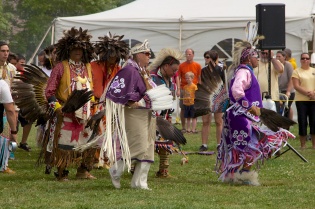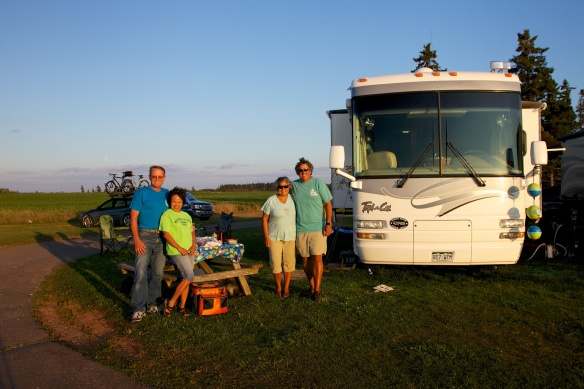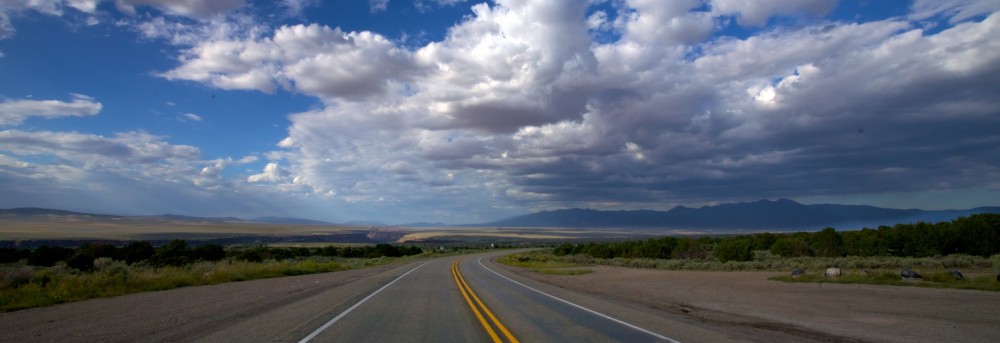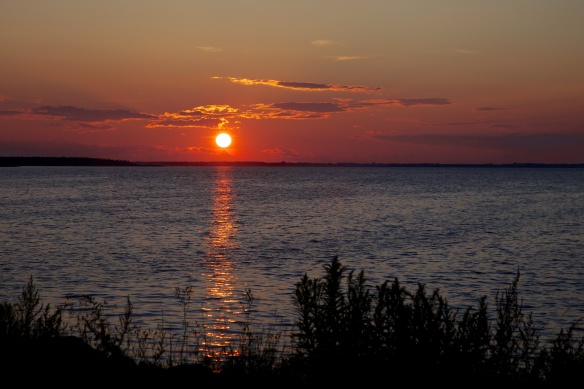 We stayed at another beautiful campsite on Prince Edward Island (PEI). It was a corner campsite overlooking Malpeque Bay (as in Malpeque oysters) near the town of Summerside. And our coach windshield faced the sunset. Perfect!
We stayed at another beautiful campsite on Prince Edward Island (PEI). It was a corner campsite overlooking Malpeque Bay (as in Malpeque oysters) near the town of Summerside. And our coach windshield faced the sunset. Perfect!

 First things first, we headed out to the wharf at the town of Malpeque to get some of those famous Malpeque oysters. They’d just come out of the water that morning and were $6.00 a dozen! We bought three dozen and had a wonderful oyster and martini happy hour/dinner. Delicious!
First things first, we headed out to the wharf at the town of Malpeque to get some of those famous Malpeque oysters. They’d just come out of the water that morning and were $6.00 a dozen! We bought three dozen and had a wonderful oyster and martini happy hour/dinner. Delicious!




 The next day we headed for Charlottetown, the largest city and the capital of PEI, with a population of over 34,000, just under a quarter of the province’s population. Back on Cape Breton Island, our car’s rearview mirror had fallen off. Hector tried to do a temporary fix to no avail. So we drove around for a while without a rear view mirror. I was happy when we found a Subaru dealer in Charlottetown and got the mirror fixed along with an oil change.
The next day we headed for Charlottetown, the largest city and the capital of PEI, with a population of over 34,000, just under a quarter of the province’s population. Back on Cape Breton Island, our car’s rearview mirror had fallen off. Hector tried to do a temporary fix to no avail. So we drove around for a while without a rear view mirror. I was happy when we found a Subaru dealer in Charlottetown and got the mirror fixed along with an oil change.
Coincidentally, on that same day the Mi’kmaq Confederacy of Prince Edward Island was having their Annual Charlottetown Pow Wow on the waterfront. So we rode our bicycles from the car dealer to downtown.
The Mi’kmaq First Nation occupied Prince Edward Island, Nova Scotia, New Brunswick, Newfoundland and portions of the Gaspé Peninsula for thousands of years. They named this territory MI’kma’ki. PEI was known to them as Abegeit – “Land Cradled on the Waves”.


 The Mi’kmaq belonged to a much larger tribal grouping, the Wabanaki Confederacy, that included the Maliseet, Passamaquoddy, Penobscot, and Abenaki tribes of Eastern North America as well as the Mi’kmaq. The Wabanaki Confederacy were members of the even larger Algonquin family which occupied lands east of the St. Lawrence River, the Adirondacks and the Appalachians.
The Mi’kmaq belonged to a much larger tribal grouping, the Wabanaki Confederacy, that included the Maliseet, Passamaquoddy, Penobscot, and Abenaki tribes of Eastern North America as well as the Mi’kmaq. The Wabanaki Confederacy were members of the even larger Algonquin family which occupied lands east of the St. Lawrence River, the Adirondacks and the Appalachians.


The Mi’kmaq lived close to waterways, and used the birch-bark canoe to travel great distances for trade and survival. They relied on their natural environment for everything they needed, and used their resources sparingly and wisely, and with great respect. Their education included traditional survival skills and knowledge of other tribes within North America.
 Early colonists relied on the knowledge and resourcefulness of the Mi’kmaq for their own survival and, during the French and Indian War, the Mi’kmaq assisted the Acadians in resisting the British during the Expulsion of Acadians.
Early colonists relied on the knowledge and resourcefulness of the Mi’kmaq for their own survival and, during the French and Indian War, the Mi’kmaq assisted the Acadians in resisting the British during the Expulsion of Acadians.
“The Mi’kmaq Confederacy of PEI unifies the Abegweit First Nation and the Lennox Island First Nation in protecting, enhancing and strengthening the Mi’kmaq Nation in Prince Edward Island.” www.mcpei.ca.

 The Mi’kmaq Confederacy of Prince Edward Island Charlottetown Pow Wow is one of a number of Pow Wows that take place during the summer and invite neighbors to enjoy music, songs and dancing.
The Mi’kmaq Confederacy of Prince Edward Island Charlottetown Pow Wow is one of a number of Pow Wows that take place during the summer and invite neighbors to enjoy music, songs and dancing.
We spent a few hours listening and watching and walked around the booths to check out various crafts. I love to see the dancers in their traditional regalia, an expression of their culture and identity – not to be referred to as costumes, which generally are not related to a person’s tradition. The dancing is hypnotic and beautiful.
They had a really funny “potato dance”. A contest to see which couple can hold a potato between their heads the longest without using their hands. The announcer has them do different moves (wiggle your hips, stand on one foot, etc) to dislodge the potato. Fun.
It was extremely hot, so we decided to do some interior touring to cool off.

 We went across the street to Founder’s Hall, a multi-media interpretive center that details the history of Canadian Confederation, starting with the Charlottetown Conference of 1864. It’s a unique presentation of the events leading to Canada’s birth. You walk through a “time tunnel” to the beginning of the presentation, which is set up using modern video coverage of a “breaking news event” with narration through headsets along with other interactive displays.
We went across the street to Founder’s Hall, a multi-media interpretive center that details the history of Canadian Confederation, starting with the Charlottetown Conference of 1864. It’s a unique presentation of the events leading to Canada’s birth. You walk through a “time tunnel” to the beginning of the presentation, which is set up using modern video coverage of a “breaking news event” with narration through headsets along with other interactive displays.
The story, in a nutshell, is that delegates from each of the then separate British Colonies came to this historic waterfront for a meeting to discuss the possibility of confederation in 1864. Each had their own motives and some were more interested than others, but eventually they all agreed. Hence Charlottetown is known as the birthplace of Canada.

 The Charlottetown Conference led to the Quebec Conference where details were finalized, which led to the London Resolutions, where a draft of the British North America Act was completed in 1867 for the union of Ontario, Quebec, Nova Scotia and New Brunswick.
The Charlottetown Conference led to the Quebec Conference where details were finalized, which led to the London Resolutions, where a draft of the British North America Act was completed in 1867 for the union of Ontario, Quebec, Nova Scotia and New Brunswick.
The Bill was approved by the House of Lords and the House of Commons, and July 1, 1867 was set as the date of the union. So Canada Day on July 1st celebrates this new confederation, the joining of several British colonies, not independence as in our July 4th.
Not all provinces immediately joined, but they ultimately did. With Prince Edward Island holding off on joining until 1873. As they joined, Canada grew “from sea to sea to sea”. Part of this was the purchase of the vast holdings of the Hudson Bay Company shortly after the US bought Alaska from Russia. Canada apparently got a really good deal compared to “Seward’s Folly”.
Full Independence from England did not come until 1982. Canada is now a Constitutional monarchy with the British monarch still as its head of state, a mostly ceremonial role.
Back to PEI, and its diverse traditions. Today, this province maintains a Celtic flavor, with a larger population of Scottish descent than Nova Scotia, which is surprising.
 And so it was time for more traditional Celtic music and dance. We enjoyed our first Ceilidh at Cape Breton Island, and wanted to check out another one. So we headed out to the Ross Family Ceilidh, in the town of Stanley Bridge, which was fairly close to us. This Ceilidh was recommended to us by a group of RVers from Bermuda and North Carolina that we met at our campground back in Bridgetown, Nova Scotia.
And so it was time for more traditional Celtic music and dance. We enjoyed our first Ceilidh at Cape Breton Island, and wanted to check out another one. So we headed out to the Ross Family Ceilidh, in the town of Stanley Bridge, which was fairly close to us. This Ceilidh was recommended to us by a group of RVers from Bermuda and North Carolina that we met at our campground back in Bridgetown, Nova Scotia.
We ran a bit late only to find that a large group of people were walking back to the parking lot because the hall where the Ceilidh was taking place was now full. Never one to give up easily, I went in to double check that they didn’t have two seats left, and found out they had one seat.
So we sat on a bench outside to see if we could at least listen for a little bit. I then thought I heard someone saying that one more seat had opened up. I ran in, and they now had two seats. So we got in, after 60 people had been turned away. Crazy!
The Ross Family is an energetic brother and sister act, very talented and entertaining. One sister plays guitar, the other the fiddle and the brother plays the piano. The sisters step dance, and are joined by their mother for one very fun number. Another brother made a guest appearance, he used to be part of the group (the drummer) but left to pursue other career interests. He was a great step dancer. A fun evening.

 Back at the campsite a few days later, we were joined by Steve and MonaLiza, fellow fulltimers that I connected with through their blog, The Lowe’s RV Adventures. We figured out that we’d both be in PEI at the same time and set a date to get together. They are a really fun couple and we had a fabulous time together.
Back at the campsite a few days later, we were joined by Steve and MonaLiza, fellow fulltimers that I connected with through their blog, The Lowe’s RV Adventures. We figured out that we’d both be in PEI at the same time and set a date to get together. They are a really fun couple and we had a fabulous time together.
We munched on Malpeque oysters, delicious appetizers that Steve made, and a berry pie that MonaLiza made (so yummy!) and watched the sunset. So nice to meet others who are living this lifestyle and enjoying it like we are. We hope to meet them again along the way.
On to other adventures across the island…




















